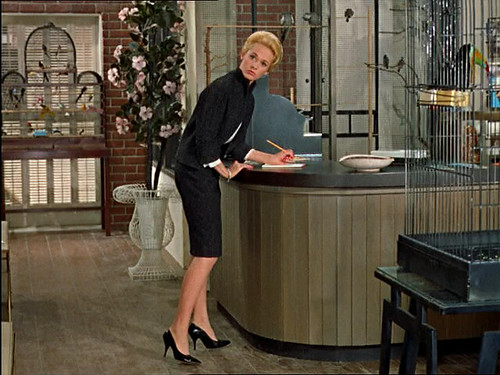
(The Birds Poster, 1963)
The Birds runs like a romantic comedy for the first 40 or so minutes of the film. But the tone changes when birds (mostly crows and gulls) begin to attack the residents of Bodega Bay in flocks.
"When teasing out the meaning of The Birds, many critics take their lead from the hysterical woman who links the attacks to Daniels' arrival ("I think you're the cause of all of this"). This implies that the birds are a manifestation of sex, some galvanic hormonal storm that whisks sleepy Bodega Bay into a great communal lather." (Brooks, 2017)
The main character, Melanie Daniels, can be compared to a harpy, a mythological monster described as having a woman's head and a birds body and claws. This is a very obvious comparison to Daniels', since she is described as a strong, headfast, and sexually open young woman throughout the film. In fact, Hitchcock often draws to this, giving us details about her life in the conversations she and Mitch Brenner have. Not only are there personality traits that can connect the two, also physical traits. She has very long, claw-like nails, and she is considered in the 1960s a beautiful woman.

(The Birds, 1963)
As Brooks says, Daniels' arrival seems to cast a "hormonal storm" and it is well known that Harpies are also a personification of storm winds in many poems. Thus it seems only natural to draw this conclusion that Daniels' is the cause of The Bodega Bay Birds attacking out of the blue upon her arrival, although the real reason is never revealed in the film.
"But the context of the birds concentrating their fury upon a house in which a possessive and jealous mother hovers anxiously over her son is so obvious and fascinating that I rather lean to it."(Crowther, 1963)
Jealousy is also a large theme in this film, mostly between the mother and Daniels'. The mother is jealous that someone could steal her son (Brenner) from her, and Daniels' is jealous of the mother for keeping Brenners attention on her. There's also Annie, the school teacher of Bodega Bay who used to date Brenner, and who is also still in love with him. She was chased off by the mother but encourages Daniels' to try, knowing she will most likely fail.

(The Birds, 1963)
"It is about three needy women (literally 'birds') - and a fourth from a younger generation - each flocking around and vying for varying degrees of affection and attention from the sole, emotionally-cold male lead, and the fragile tensions, anxieties and unpredictable relations between them." (Filmsite.org, 2018)
At Filmsite says, the film is not about these birds attacking people, its about jealousy of these women ("birds). All through the film these women are fighting for attention from Brenners, but in the end, after Daniels' gets attacked they realise that there's no point in bickering, because Brenners cares for them all equally.
Bibliography:
Images:
Quotes:
Bibliography:
Images:
Your Bibliography: The Birds Poster. (1963). [image] Available at: https://images-na.ssl-images-amazon.com/images/I/51n50YDJYUL._SL500_AC_SS350_.jpg [Accessed 28 Feb. 2018].
The Birds. (1963). [DVD] Directed by A. Hitchcock. United States: Universal Pictures.
Quotes:
Brooks, X. (2017). My favourite Hitchcock: The Birds. [online] the Guardian. Available at: https://www.theguardian.com/film/filmblog/2012/jul/31/my-favourite-hitchcock-the-birds [Accessed 28 Feb. 2018].
Crowther, B. (1963). Movie Review - - Screen: 'The Birds':Hitchcock's Feathered Fiends Are Chilling - NYTimes.com. [online] Nytimes.com. Available at: http://www.nytimes.com/movie/review?res=9D05E7D9143CEF3BBC4953DFB2668388679EDE [Accessed 28 Feb. 2018].
Filmsite.org. (2018). The Birds (1963). [online] Available at: http://www.filmsite.org/bird.html [Accessed 28 Feb. 2018].









